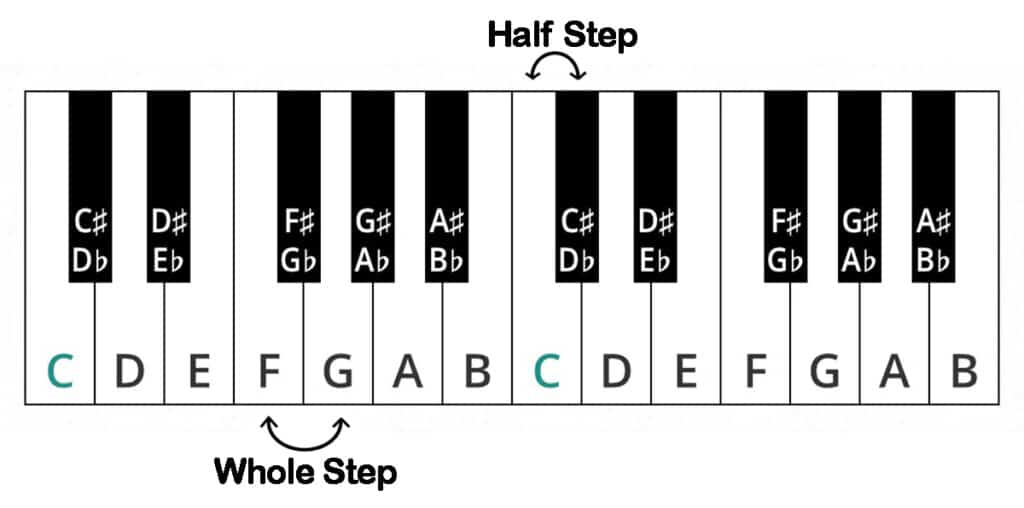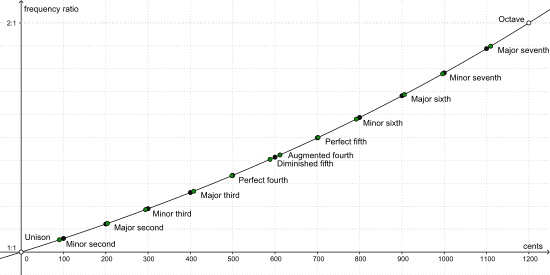Whole tones and half tones, the fundamental building blocks of musical intervals in Western music, play a crucial role in shaping the harmonic and melodic landscape of compositions. These basic units, consisting of whole steps and half steps, help define the structure of scales and chords, creating a sense of familiarity and expectation for listeners.
By delving into the world of whole tones and half tones, we uncover the foundation of music and how these elements can be manipulated to evoke a wide range of emotions and atmospheres.

What Is A Whole Step?
A whole step, also known as a whole tone or simply a tone, is a musical interval in Western music that refers to the distance between two adjacent notes on a diatonic scale. It is equivalent to two half steps or semitones.
For example, on a piano, a whole step between C and D would include the notes C#, or Db. Another example is the whole step between F and G, which would include the notes F#, or Gb.
In a major scale, whole steps are found between the 1st and 2nd, 2nd and 3rd, 4th and 5th, and 5th and 6th scale degrees.
For example, in the C major scale, a whole step exists between the notes C and D, D and E, F and G, and G and A. On a piano keyboard, a whole step is the distance between a white key and the next white key with a black key in between.
In terms of musical notation, a whole step is indicated by the symbol “W” or “2” above or below the notes that are being played or sung.
What Is A Half Step?
A half step, also known as a semitone or half tone, is the smallest musical interval in Western music. It is the distance between two adjacent notes on a chromatic scale.
On a piano keyboard, a half step is the distance between a key and its immediate neighboring key, whether it is a white key or a black key. For example, on a piano, a half step from C would be C# or Db, depending on the context. Similarly, a half step from F would be F# or Gb.
In musical notation, a half step is indicated by the symbol “H” or “1” above or below the notes being played
What Is The Difference Between A Whole Step And a Half Step?
The difference between a whole step and a half step lies in the distance between two notes in Western music:
Half step (semitone or half tone): A half step is the smallest musical interval in Western music. It represents the distance between two adjacent notes on a chromatic scale. On a piano keyboard, a half step is the distance between a key and its immediate neighboring key, whether it is a white key or a black key.
Whole step (whole tone or tone): A whole step is equivalent to two half steps or semitones. It represents the distance between two notes on a diatonic scale, with one note in between. On a piano keyboard, a whole step is the distance between a white key and the next white key with a black key in between.
In summary, a whole step is twice the size of a half step. These intervals are fundamental building blocks of scales and melodies in Western music.
What Are Cents? How Many Cents Is A Semitone?
In Western music, a semitone, which is also known as a half step, is equal to 100 cents.
In music theory, cents are a unit of measurement used to describe and compare musical intervals, particularly the relative pitch between two notes. A cent is a logarithmic unit, and there are 1,200 cents in an octave. Cents are a useful unit because it allows for a more precise and standardized way of comparing intervals across different tuning systems.
Cents are a logarithmic unit, which means that the difference between two pitches in cents is proportional to the ratio between their frequencies.
For example, if one note has a frequency of 440 Hz and another note is a semitone higher, its frequency would be 440 Hz x 2^(1/12), which is approximately 466.16 Hz. The frequency ratio between the two notes is 466.16/440, which is equal to 1.0595. In cents, this difference can be expressed as:
1200 x log2(1.0595) ≈ 100 cents
Therefore, a semitone is equivalent to 100 cents, and each octave is equal to 12 semitones or
1200 cents.

The division of an octave into 1,200 cents means that each half step (or semitone) in a standard 12-tone equal-tempered scale contains 100 cents. For example, the distance between C and C# (or Db) on a piano keyboard would be 100 cents, while the distance between C and D (a whole step or whole tone) would be 200 cents.
Need help remembering notes? Refer back to the lesson on What are Notes?
Cents are particularly useful when discussing microtonal music, alternative tuning systems, or minute differences in pitch that cannot be easily expressed using traditional interval names like half steps or whole steps.
Semitone Examples
How Many Semitones In A Major 3rd?
A major 3rd interval consists of four semitones or half steps. For example, in the C major scale, the major 3rd interval is between C (the root) and E (the 3rd note). To count the semitones, you would move from C to C# (1st semitone), C# to D (2nd semitone), D to D# (3rd semitone), and finally, D# to E (4th semitone).
How Many Semitones Is A Perfect 5th?
A perfect 5th interval consists of seven semitones or half steps. For example, in the C major scale, the perfect 5th interval is between C (the root) and G (the 5th note). To count the semitones, you would move from C to C# (1st semitone), C# to D (2nd semitone), D to D# (3rd semitone), D# to E (4th semitone), E to F (5th semitone), F to F# (6th semitone), and finally, F# to G (7th semitone).
How Many Semitones Are In An Octave?
There are twelve semitones in an octave. An octave is the interval between two notes where the frequency of one note is exactly double (or half) the frequency of the other note. This interval is considered one of the most basic and important intervals in Western music because it is the most harmonious.
The twelve semitones in an octave are named using the first seven letters of the alphabet: A, B, C, D, E, F, and G. Each of these notes has a sharp (#) or flat (b) variant, which is used to represent the notes in between the whole steps. For example, the note between A and B is A#, and the note between B and C is Cb.
The sequence of twelve semitones in an octave is commonly referred to as the chromatic scale. This scale includes all twelve notes within an octave, including the natural notes and their sharps or flats. The chromatic scale provides the foundation for much of Western music theory, including harmony, melody, and chord progressions.
What Is A Whole Tone Scale?
A whole tone scale is a musical scale that consists entirely of whole steps, or whole tones, as opposed to half steps or semitones. This means that there are no half steps within the scale, and each note is a whole step away from the previous note.
In a whole tone scale, there are six notes in an octave, as opposed to the more common seven notes found in major and minor scales. Because of the consistent intervallic structure of whole steps, the whole tone scale is considered a symmetrical scale.
There are only two whole tone scales, due to the nature of the intervals involved. One of them starts on C, and the other starts on C#. These scales have only six notes each since there are no half steps in between them.
The most prominent example of a whole tone scale can be formed starting on C and ascending as follows: C, D, E, F#, G#, A#, and back to C. The other whole tone scale can be formed starting on C#: C#, D#, F, G, A, B, and back to C#.
Whole tone scales are symmetrical, meaning that they are made up of the same interval repeated several times. They also lack a clear tonal center, which means that they don’t have a strong sense of resolution or finality that is common in other scales. This can make them challenging to use in certain contexts, but they can also be used to create unusual and experimental sounds in music.
The whole tone scale is often associated with an impressionistic or dreamy sound and has been used by composers such as Claude Debussy and jazz musicians like Thelonious Monk to create a unique harmonic landscape.
The scale’s symmetry and lack of a defined tonal center make it a useful tool for composers and improvisers who want to explore a more ambiguous and less predictable harmonic palette. This can make them challenging to use in certain contexts, but they can also be used to create unusual and experimental sounds in music.
Because there are no semitones in a whole tone scale, it lacks the leading tones and strong resolutions typically found in diatonic scales, which contributes to its distinct, otherworldly character.
Whole tone scales can be used in various ways, such as:
- Harmonic context: The whole tone scale can provide a unique harmonic framework for compositions or improvisations, offering an alternative to traditional major and minor key structures.
- Melodic material: Melodies based on the whole tone scale can evoke a sense of mystique, tension, or ambiguity, as the listener is not guided by familiar tonal relationships.
- Modulation: Composers can use whole tone scales to bridge different tonal areas or to create smooth modulations, as the symmetrical nature of the scale can be easily transposed or shifted.
Conclusion
The concepts of whole tones and half tones are essential to the understanding of Western music theory. These basic units serve as the foundation for the construction of scales and chords, establishing familiar patterns and relationships that create a sense of coherence and expectation.
However, as demonstrated by the whole tone scale, the manipulation and subversion of these conventions can lead to innovative and captivating musical expressions.
By exploring the possibilities afforded by whole tones and half tones, composers and musicians have unlocked new ways of thinking about music, allowing for a broad range of emotional and atmospheric effects.
Go to next lesson: Coming Soon
Go to previous lesson: What Are Sharp, Flat, And Natural Notes In Music?
Back to: Module 1


